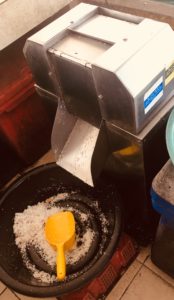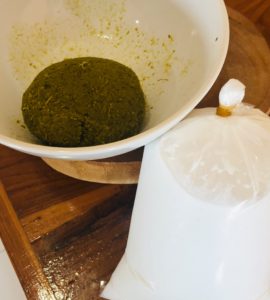We were big fans of America style Thai food before we traveled to Thailand, but now that we have been here for a couple of months, we have grown to appreciate the subtly of flavors that fresh ingredients and a skilled hand in the kitchen can make. In this article will explore the ingredients and walk through the preparation of one of the stapes of any Thai menu, Green Curry Chicken.
First about the ingredients:
- Coconut Cream and Coconut Milk: while we were at the open market this morning we watched a lady preparing coconut cream.
- Large chucks of fresh coconut were fed into a machine that looked like a miniature wood chipper. Chunks of coconut in the top, shredded coconut into a collection pan at the bottom.
- The shredded coconut was then spooned into a cloth bag and placed into a press. The resulting thick liquid, rich coconut crème, was collected in a bucket under the press.
- This was then bagged up and presented to us to take home. 400 mls of coconut crème (about 13 ounces) costs us $0.60 USD



-
-
- Some notes:
- To get coconut milk, just add some water to the shredded coconut and run it through the press again.
- You can get about the same results at home by running fresh coconut through the food processor and then squeezing the results through a clean dish towel or cheesecloth.
- Don’t try to use store bought products such as Crème de Coco as this has added sweetners and will throw off the taste of your curry. Save the Coco Lopez for making Pina Coladas.
- Some notes:
-
- Chicken: breast meat, the fresher the better! The chicken we buy at the outdoor markets today was probably running around the yard this morning.
- Green Curry Paste: given the extremely limited kitchen and the availability
 of so many fresh curry paste options, we have opted to purchase our curry paste.
of so many fresh curry paste options, we have opted to purchase our curry paste.
-
- At home we would probably have made it from scratch using dry
ingredients (coriander seeds, cumin seeds, black peppercorns, salt) and fresh ingredients (garlic, Thai ginger, turmeric, kaffir lime peel, lemongrass, shallots, coriander root, sweet basil leaves and green “birds eye” chilis).
- At home we would probably have made it from scratch using dry
-
- Eggplant: unlike many ingredients that are just used for flavor while cooking and then discarded, eggplant adds not just flavor but also texture and substance to the curry. There are many different kinds of Thai eggplant, some look like small cucumbers, while others are the size of large marbles and still
 others are about the size of large green peas. Mix them up and have fun.
others are about the size of large green peas. Mix them up and have fun. - Kaffir Lime Leaves: the kaffir fruit is from the citrus family, but unlike lemons or limes it has a tough bumpy skin which is used in making curry paste. The leaves are used for flavor (the hard center stalk is removed the edges of the leaves are added). Much like bay leaves in Italian cooking, the leaves are removed after cooking. The inside fruit has a very bitter orange taste and is not commonly used for cooking.
- Red Chili: in the case of green curry, sliced red chilis are used mainly as garnish. The green curry paste has several small green “birds eye” chilis added during its preparation, the more chilis the spicier the paste.
- Since we’ve been here we have learned that chilis are used to compliment the flavor of Thai food. Food that is too spicy is not properly balanced. The addition of chili should not be used as a test of manhood or as a punishment for eating Thai food.
- Palm Sugar: we were actually a bit surprised to learn how often sugar is used in Thai cooking. Thick
 creamy Palm Sugar (called coconut sugar locally) is almost the consistency of peanut butter and is used to sweeten curry, salads and desserts. If you cannot get palm sugar you can substitute brown sugar or raw honey.
creamy Palm Sugar (called coconut sugar locally) is almost the consistency of peanut butter and is used to sweeten curry, salads and desserts. If you cannot get palm sugar you can substitute brown sugar or raw honey. - Sweet Basil Leaves: basil leaves come in any different forms such as
 honey basil, lemon basil or even Holy Basil “Holy Basil batman!”.
honey basil, lemon basil or even Holy Basil “Holy Basil batman!”. - Green Beans: these are optional, but we like them in our curry. Thai green beans tend to be much longer than American style green beans, but either kind will work.

- Fish Sauce: fish sauce is a staple of much of Thai
 cooking and can easily be found in grocery stores around the world. Fish sauce is best when fresh and unlike wines, it does not get better with age. If you have a open jar of fish sauce that has been in your cabinet for years, get rid of it and buy a fresh one!
cooking and can easily be found in grocery stores around the world. Fish sauce is best when fresh and unlike wines, it does not get better with age. If you have a open jar of fish sauce that has been in your cabinet for years, get rid of it and buy a fresh one!
The Recipe: (serves two):
• ½ cup coconut cream
• ½ cup coconut milk
• 1/3 to ½ cup chicken breast chopped into small cubes
• 1 tablespoon green curry paste
• Eggplant (1 large and 3 or 4 small, stemmed and cut up)
(If you have them you can throw in a small handful of the pea sized as well)
• 1 Kaffir Lime Leaf: fold in half and strip out the hard center stem
• ½ tablespoon of palm sugar
• 2 or 3 green beans cut into 2 inch sections
• 1 large red chili, cut into thin strips
• 1 tablespoon full of fish sauce
• 1 cup of jasmine rice, cooked.
Preparation is shown in the video below.
Serving suggestion: place half of the cooked rice into a plate and half of the curry into a small bowl for each person. Garnish the curry with the strips of red pepper. Service with an icy cold Thai beer such as Leo or Singha. Enjoy!


